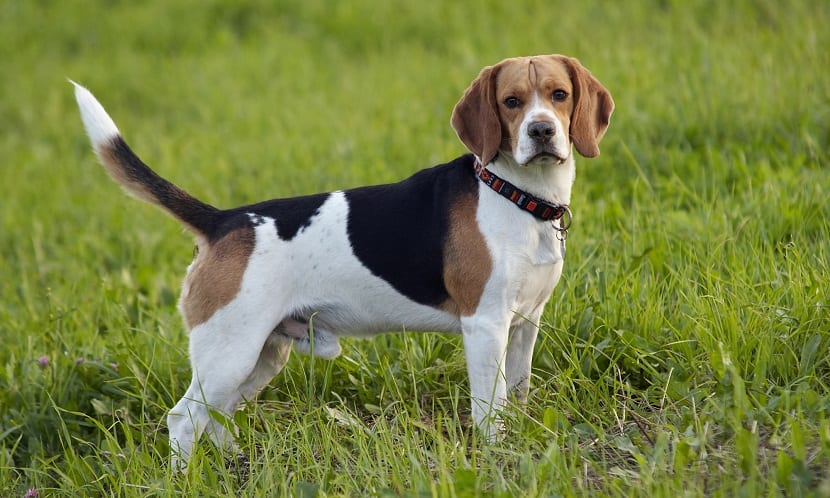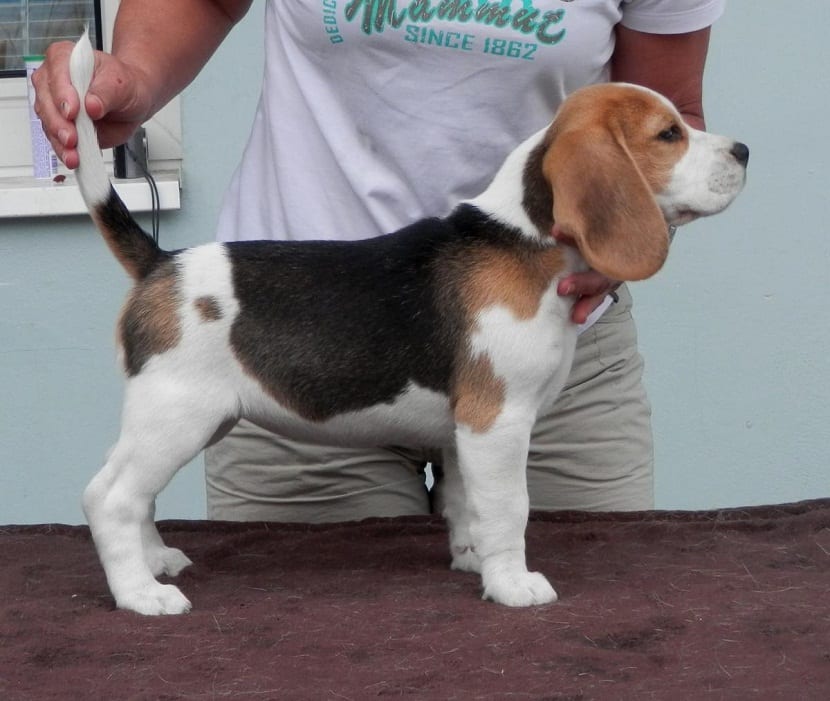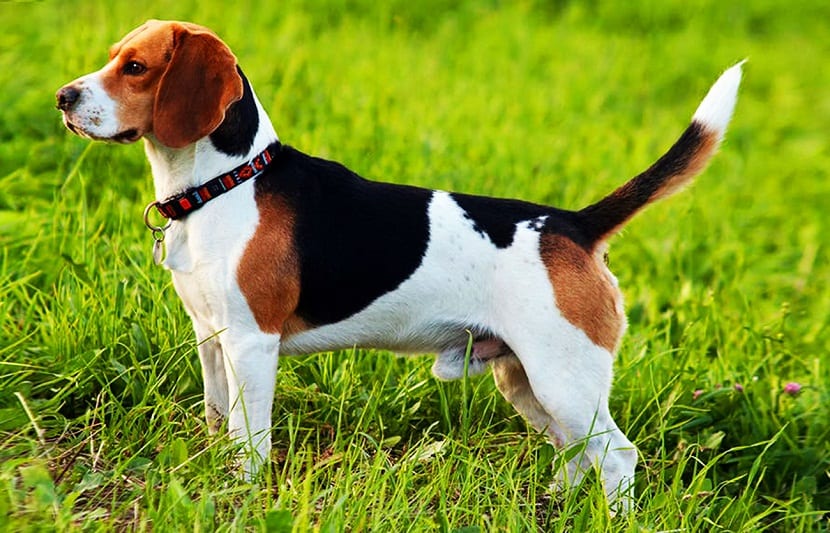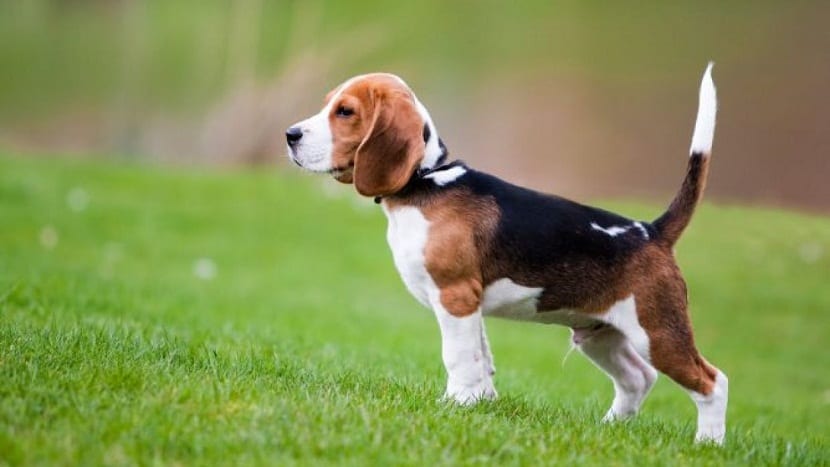
The English Foxhound It is a hound type dog that is among the most appreciated breeds in England. This mascot's relationship with the aristocratic sport of hunting has earned it a place in the hearts of the English. Their characteristic image is immediately related to beagle dogs and it cannot be denied that their temperament is very sociable and friendly.
The English foxhound breed has been developed with special attention and care. All hatchlings can be traced for generations and their breeding has been so selective and scientific that these pets have practically no genetic diseases.
Origin and history of the English foxhound

These dogs have a rich history and very specific characteristics. Knowing the greatest amount of information about the English foxhound helps to clear up doubts regarding coexistence with these pets and to know the best recommendations for their care. It will also help you decide if it is the best option to incorporate as a companion dog.
The history of the English foxhound and its relationship with hunting dates back to the XNUMXth century. The Red fox hunting has been one of the oldest and most aristocratic English traditions. It was always done on horseback with a pack of hound dogs, among which the foxhound stands out. Due to its performance, the smell of this dog is highly developed and it is extremely complacent with its owners.
The foxhound's ancestors include the St. Hubert's dog, the English greyhound, and the Greyhound. The breeders of this breed enjoy great prestige in England and they are called Foxhound Masters. Genealogical records dating back 200 years are available, and each foxhound calf can be tracked in detail in any of the 250 existing packs.
Features
Due to its friendly nature, it has started an interesting journey that has introduced it to homes as a companion dog. However, it is recommended that owners who adopt an English foxhound are very aware that require a lot of physical activity. It has an athletic, powerful style and its proportions are harmonious and elegant. The height at the withers is between 58 and 64 centimeters with an average weight of 28 kilograms.
The head has a flattened and moderately wide skull and is proportionate to the body. The naso-frontal depression is not very accentuated and the muzzle is long and somewhat square with wide windows and a black nose. The eyes are medium-sized, almond-shaped and hazel or brown in color. and the ears are drooping.
The back is broad and horizontal, the chest deep, and the ribs slightly arched. The tail is set high and the dog normally carries it high and should never fall on its back. The coat is short, dense, double-layered waterproof, shiny and rough. It can be any color and any accepted brand on hounds. It usually comes in three colors: black, white, and tan.
Temperament

The temperament of the English foxhound is defined by the experiences repeated by several generations being recorded in the genetics of the pet. It is a very sociable dog used to joining the herd and being very accommodating to their owners. The duty of this hound was to hunt down and identify the fox making it quite noisy. He is highly energetic and games and walks balance character. If they spend a lot of time alone they become sad and if they are treated badly they become nervous. Lack of energy can make them anxious and destructive. Education begins from puppies and it is important to remember that as a pack dog it follows the alpha male that it sees reflected in the owner.
The desire to please leads them to easily follow instructions, a quality that is very useful for training. They get along well with children and enjoy playing tirelessly with them. They are not suitable companion pets for people with a sedentary lifestyle, as is the case with the american foxhound.
Care
Once the foxhound calf is weaning should be fed with a puppy food, since they contain the necessary nutrients for this stage of development, and add some liquid medium recommended by the veterinarian that gives the food the consistency of porridge. The first visit to the vet is very important because it will define the regularity with which you should attend the consultation and the necessary vaccinations will be applied. The vaccination schedule must be strictly adhered to. You must also be very aware of deworming.
The diet varies when it is an adult dog, however in the specific case of this breed, you should ask for veterinary advice on the amount of daily servings since physical activity and energy expenditure have a decisive influence on the amount of calories you should eat. Although the breed does not tend to be obese, keeping them at the right weight is very important. You should bathe only when necessary once a month or every two months. Brushing the coat should be done once or twice a week to remove dirt, mites, etc. This activity also strengthens the bond between owner and pet.
The most important part of caring for the English foxhound is physical activity. These pets require from four daily walks to a minimum of three. They should also be entertained with games of agility, intelligence, and given something to track. Failure to provide the required activity seriously affects his emotional balance.
"Salud"

The foxhound breed can live in perfect condition for 13 or 14 years. The health of these dogs is among the best of the bloodhounds. The weakest aspect is the eyes that are susceptible to disease. However, this risk in these pets is much lower than in other breeds. He practically does not suffer from genetic diseases.
The only one that has a relevant incidence is leukodystrophy, in which there is a more or less rapid loss of myelin, a substance of the nervous system. The obvious symptoms are that the dog is wobbling, presents incoordination and progressive weakness, that is, canine ataxia. To detect this disorder quickly, it is recommended to make regular visits to the veterinarian, every 6 or 12 months and perform blood tests.
It is not recommended to make it live with smaller pets, such as rabbits, since it will see it as prey. On the other hand, this behavior makes him chase rodents and then bring them to the owners expecting gratification. Foxhound education is not difficult and should always be supplemented with positive reinforcement such as rewards, strokes, and words of encouragement. With patience it becomes an excellent pet and while it continues to evolve the ideal is to offer it open spaces for its recreation.